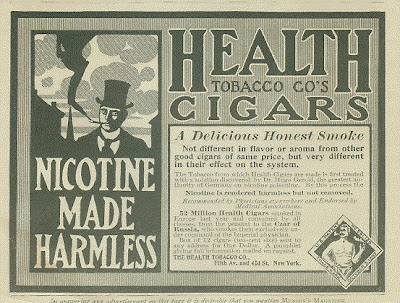 A new exhibition hosted by The New York Public Library examines the historic advertisements in which tobacco companies claimed that smoking provided a range of health benefits, including the ability to calm nerves, boost energy and aid in weight loss. That’s one from my personal collection at left.
A new exhibition hosted by The New York Public Library examines the historic advertisements in which tobacco companies claimed that smoking provided a range of health benefits, including the ability to calm nerves, boost energy and aid in weight loss. That’s one from my personal collection at left.
Not a Cough in a Car Load: Images Used by Tobacco Companies to Hide the Hazards of Smoking, an historical, multi-faceted and thought-provoking exhibition examining the methods tobacco companies took to promote their products, will be on display at The New York Public Library’s Science, Industry and Business Library‘-s Healy Hall at 188 Madison Avenue, from October 7 to December 26, 2008. Admission is free. A related event featuring a lecture by the exhibition’s curator, Dr. Robert Jackler, including the presentation of vintage video advertisements for tobacco products, will be held on Tuesday, December 9, from 5:30 to 7:30 p.m.
Dr. Jackler, an associate dean of Continuing Medical Education at Stanford University, created the revealing look at the tobacco industry after his mother, a longtime smoker, was diagnosed with lung cancer. Aiming to raise awareness of advertising practices at the time, the exhibit contains boldly designed eye-catching images collected from such publications as Life and the Saturday Evening Post and ranging in date from 1927 to 1954. All images have been returned to their original, vibrant form through digital enhancement.
“Due to our current knowledge of the dangers involved with cigarettes, some of the images are actually humorous in nature and while we are having some fun with the exhibition, this is also a compelling story about the way the tobacco industry kept people smoking for generations,” said Dr. Jackler.”We are talking about an industry that put profits above all consideration for its customers’ well-being.It is still relevant today, because while the ads are much more subtle and constrained, the message and goals are still the same.”
The exhibit debuted at Stanford University in January 2007 and has been shown at the University of California and Harvard Medical prior to its run at the library.
“Not a Cough in a Carload takes a look at the power of image and serves as a follow-up to other advertising exhibitions we have hosted,” said John Ganly, SIBL’s assistant director for collections.”It is also a perfect complement to the great collections at the library that deal with the issues of smoking.”
In addition to images of such luminaries as Rock Hudson, John Wayne, Joe DiMaggio, a pre-presidential Ronald Reagan, and Santa Claus smoking tobacco products, advertisements also depict unidentified doctors with cigarettes in hand accompanied by the claim that “More Doctors Smoke Camels than Any Other Cigarette.” Another features a statistic that 󈬖,381 Dentists Say, ‘Smoke Viceroys,’” before the bold statement that the filtered brand “Can never stain your teeth.”
“They used images of doctors to reassure the public, but these characters came right out of central casting and only looked like doctors,” said Dr. Jackler.”The medical profession didn’t complain, because the ads made doctors appear noble. And the public were taken in by the ads, because if a doctor smokes, it must be ok.”
The popular “Reach for a Lucky, Instead of a Sweet” campaign by Lucky Strike is also featured, as tobacco companies wooed weight-conscious consumers. Lucky Strike, among other cigarette companies, is also featured in ads tackling “smoker’s cough,” as a brand good for the throat. In addition to the medicinal effects of cigarettes, claims made about tobacco’s effects on smokers’ moods are also examined in vivid detail, along with images of advertisements Dr. Jackler believes were directed at kids in the Sunday “funnies”.
In a separate area leading to the main exhibition, the library will include documents from the George Arents Collection on Tobacco on display along with three-dimensional materials, such as actual magazines featuring cigarette advertisements and boxes of candy cigarettes.In addition, a research guide culled from various documents at The New York Public Library, featuring government papers, Surgeon General reports and hearings dealing with tobacco advertising, will be made available. A guest book will also allow visitors to express their reactions to the exhibition.
Not a Cough in a Car Load: Images Used by Tobacco Companies to Hide the Hazards of Smoking will be on view from October 7 to December 26, 2008 in Healy Hall at the The New York Public Library’s Science, Industry and Business Library, located at 188 Madison Avenue. Exhibition hours run Monday, Friday and Saturday, from 11 a.m. to 6 p.m.- and Tuesday through Thursday, from 10 a.m. to 8 p.m.Admission is free. For more information, call (212) 592-7000 or visit www.nypl.org.
